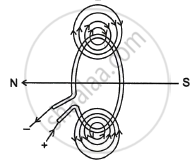Advertisements
Advertisements
Question
The correct pattern of magnetic field lines of the field produced by a current carrying circular loop is:
Options
Solution

Explanation:
Magnetic field lines enter from the south pole and exit from the north pole. A circular coil that conducts current has curved lines, a straight line running through the centre, and concentric circles at the coil's two opposite ends.
APPEARS IN
RELATED QUESTIONS
The back face of a circular loop of wire is found to be south magnetic pole. The direction of current in this face of the circular loop of wire will be:
(a) towards south
(b) clockwise
(c) anticlockwise
(d) towards north
A wire, bent into a circle, carries current in an anticlockwise direction. What polarity does this face of the coil exhibit?
What is the direction of magnetic field at the centre of a coil carrying current in clockwise ?
Which of the statement given below correctly describes the magnetic field near a long, straight current carrying conductor?
A magnet kept at the centre of two coils A and B is moved to and fro as shown in the diagram. The two galvanometers show deflection. State with a reason whether : x > y or x< y [x and y are magnitudes of deflection.]

Answer the following question.
Explain with the help of the pattern of magnetic field lines the distribution of the magnetic field due to a current-carrying a circular loop.
An induced emf is produced when a magnet is moved into a coil. The magnitude of induced emf does not depend on ____________.
The nature of magnetic field line passing through the centre of current carrying circular loop is ____________.
Why does a magnetic compass needle pointing North and South in the absence of a nearby magnet get deflected when a bar magnet or a current carrying loop is brought near it. Describe some salient features of magnetic lines of field concept.
Explain with the help of a labelled diagram the distribution of magnetic field due to a current through a circular loop. Why is it that if a current carrying coil has n turns the field produced at any point is n times as large as that produced by a single turn?



